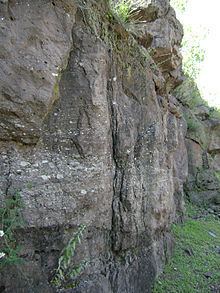Named for Passaic | Underlies Orange Mountain Basalt | |
 | ||
Thickness maximum of over 19,685 feet (6,000 m) | ||
The Passaic Formation is a mapped bedrock unit in Pennsylvania, New Jersey, and New York. It was previously known as the Brunswick Formation since it was first described in the vicinity of New Brunswick, New Jersey. It is now named for the city of Passaic, New Jersey, which is near where its type section was described by paleontologist Paul E. Olsen.
Contents
Description
The Passaic is defined as a reddish-brown shale, siltstone and mudstone with a few green and brown shale interbeds; red and dark-gray interbedded argillites near the base. In New Jersey, there are conglomerate and sandstone beds within the formation.
Depositional environment
The Passaic is mostly playa and alluvial fan deposits resulting from the rifting of Pangea. The red color is often evidence that the sediments were deposited in arid conditions. Interfingered with the Passaic, the Lockatong Formation are lake sediments, which were deposited during wetter climatic cycles during the late Triassic. These sediments came from the northwest and contain clasts from Appalachian formations.
Age
Relative age dating of the Passaic places it in the Late Triassic to the Early Jurassic, being deposited between 225 and 190 (±5) million years ago. It rests unconformably a top many different formations of the Appalachian Piedmont. It interfingers with the Lockatong Formation and also rests conformably atop the Stockton Formation. There are numerous diabase intrusions into the Passaic with local contact metamorphic rocks.
